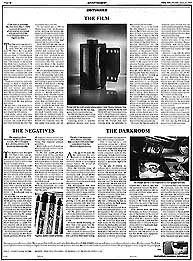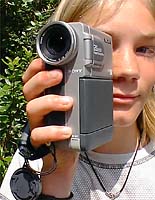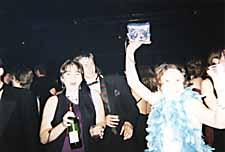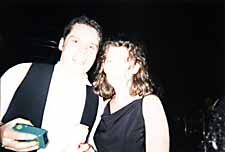
Film, Negatives & Darkroom
Declared Dead by Olympus
Has silver-halide committed suicide in the face of digital imaging?
by John Henshall
Did you see the full-page Olympus advertisement
for digital imaging in the daily papers recently? I had a call asking if I had seen it, 'It confirms what you've been saying for years.' I rushed out to buy the paper.
It's a clever ad, worth reading if only to stir your blood, though it certainly is not what I have 'been saying for years.'
Click the ad to view a readable version (198KB).
What, then, was film's response to this advert? Well, there was the usual indignant bleating in the photo press, letters to 'Amateur Photographer', that sort of thing. But, so far as I am aware, no one gave it the Mark Twain 1897 cable treatment, 'The reports of my death are greatly exaggerated.'
The Obituary as it appeared in the Press
 At the same time this advert was appearing,
Elizabeth Pattison BA was graduating from Leeds University. A keen amateur
photographer, she wanted to capture, preserve and share the memories of
the fun at her graduation ball.
At the same time this advert was appearing,
Elizabeth Pattison BA was graduating from Leeds University. A keen amateur
photographer, she wanted to capture, preserve and share the memories of
the fun at her graduation ball.
Now it is not unknown for such events to become quite boisterous, even to have alcoholic beverages sloshing around. So our new graduate, freshly steeped in all the latest digital technology, decided against risking her Leica M6 and, instead, chose to use...
Yes, you've guessed it. Not the new Olympus digital compact film-killer but a single-use 35mm camera using the old dead stuff itself.
In these days when everything is 'going digital', the word 'digital' equates with the word 'better' in the minds of most consumers. It's easy to understand why - though you must have matured considerably to be able to remember all the pre-digital methods we used.
Who remembers the pre-digital world of cash, when we had to write out a cheque and visit a bank between the hours of 10am and 3.30pm - Monday to Friday only, of course? Today's digital cash cards, via hole-in-the-wall ATMs, make it easy to get cash 24 hours a day, 365 days a year, wherever in the world you may be.
Who remembers the pre-digital days of recorded music, when a SME arm followed a dampened Dust Bug around twelve inches of undulating black vinyl spinning atop a Garrard 301 turntable? All this precision still could not prevent the addition of spurious clicks and pops to the quieter passages from the great composers. Then digital audio CD brought us studio quality music and the portable technology to enjoy it wherever we wish - even on the beach or in the air - and, within months, LPs virtually disappeared from the shops.
Who remembers the pre-digital days of telephones, when rotary dials connected you automatically to anywhere - so long as it was within a twenty mile radius? Any other call had to be connected by the operator. The line probably crackled a lot. Today's GSM cellphones allow you to roam the world, making calls and being contacted almost anywhere using the same number.
Who remembers the pre-digital days of word processing, with Tipp-Ex®, carbon paper and the bashing and clashing of typebars? Start collecting old typewriters today, while you can get them free. When most of them have been scrapped, they will become sought-after mechanical marvels of the pre-digital age. Meanwhile, typing continues. Now the words appear on the face of a screen, in any typeface, size and style you wish, automatically justified and spell checked by a word processor, which also allows you to incorporate images in your documents. The computer you use to run your word processor will also enable you to send your words and images around the world - just as I am sending this column from France, to Steve Bavister, gallantly holding the fort in the UK. (Actually, I'm on the Côte d'Argent's splendid Atlantic beach scribbling with pen on paper. The conversion to digital comes later, assisted by a glass of the local Claret.)
And who remembers the pre-digital days of imaging, when we loaded rolls of coated plastic into the camera? And the arcane business of dunking the plastic in chemical solutions to reveal the images?
We still remember this, because it is one major area where 'digital' does not mean 'better'. Film is very much alive.
The public has a natural expectation that a digital camera, which looks like a 35mm compact but costs many, many times more, will bring them features, performance and image quality at least as good as a 35mm compact. But here's the rub: none of them do and it's getting digital imaging something of a bad reputation.
Let's take a look at the advantages of digital compacts similar to the one in the advert.
No more film to buy, no more processing to wait for, to pay for. If you want a picture now, you get a picture now well, almost almost as 'now' as a Polaroid if you choose a digital camera that saves the images in a standard image format on removable media - such as a PC card - which unplugs from the camera and then plugs directly into your laptop. If the camera takes one of the other smaller cards, make sure that a PC card adapter is available for it. If not, avoid that model, for card drives bought as accessories can be very expensive. Cameras which record on removable media are the only sensible answer unless you are prepared to risk digital constipation when on-board storage fills up. If you want 36 pictures and have a camera which connects using a serial cable, then you'd better have a lot of patience. This is where you find out just how labour intensive digital imaging can be.
Some cameras have colour LCD screens which allow images to be framed accurately and reviewed immediately. This is a clear advantage over film. Unfortunately some manufacturers also use such un-shaded LCDs as the sole viewfinder. This is a clear design fault. They have never tried framing images on them in bright sunlight or seen a Hasseldblad's folding hood and magnifier.
Other advantages? Now I'm struggling.
Battery life, perhaps? No, digital compacts are an Ever Ready shareholders' dream come true. Now I'm really struggling.
Longer, wider zoom range? More sensitive? Superior colour quality? Better latitude? No.
Higher definition? No way. Resolution similar to 35mm film is available - at about £25,000 - but definitely not in a compact.
Yet, despite all these drawbacks, digital cameras are creating a whole new market as computer peripherals. People like having control over their own images, the facility to process them themselves immediately and experiment with them. And not all images need to have full 35mm film quality. Images for the Internet are one example of the use of low resolution digital images, images for inclusion in reports and other documents are another, even small editorial pictures. Low resolution digital cameras empower us to do that.
But if we do want to match the quality of 35mm in digital terms we need an 1800x1200 pixel image to deliver full resolution to a 300 pixel per inch printer just to match the quality of the popular 6x4 inch photographic print. That's a 6.3MB file just to match the quality of a photographic print - a print which, as we know, does not exploit anywhere near the full potential of a 35mm negative. To match fully the resolution of 35mm film we need files bigger than 20MB. Digital cameras with 640x480 pixel sensors deliver only 0.9MB files. Even 1280x960 digital cameras only give 3.6MB files. The effects of intense in-camera compression also work against digital image quality though, fortunately for digital imaging, a modest amount of image enhancement soon fools us into believing that image quality is somewhat better.
One of the best (and cheapest) 640x480 pixel cameras, in terms of image quality and colour, is the Agfa ePhoto307. This is not a professional digital camera but I have used it for the editorial images later in this article, just to show what it is capable of. Auto-exposure and auto-focus are good but framing at close quarters is impossible, except by guesstimation, not only because of parallax but also because the viewfinder shows only a portion of what the lens sees.
I have brought five cameras with me on holiday: my Nikon F4, with a range of lenses from 15 to 200mm, Canon Ixus APS camera, Agfa ePhoto307, Fuji DS-7 and Sony DCR-PC7E.
The Nikon hasn't been out of the bag. Too much kit to lug around the beach, nervous about sand.
The Ixus has had a film loaded and one shot taken - to show someone how small and easy APS can be. But I am ever mindful of the questionable quality and high-price processing.
The ePhoto307 has had quite a lot of use. For a serial device (one which connects to the computer via a cable) it works well and quite fast. Best of all, the exposure control and colour, even with flash, are always spot-on. But the anonymous, compressed camera files will mostly never be seen again. To save them all as TIFFs would bump up their size to 900KB from their native 42 - 48KB and fill up my PowerBook. And it would take me a long time.
The same applies to the Fuji DS-7, though the children love this camera because of its ability to review their pictures immediately. This is, potentially, an excellent photographic training tool. Of course, I brought a recharger and a good supply of nickel-cadmium batteries.
Finally, the Sony DCR-PC7E - a digital camera, of course, but with some very nice features. It has a 10-to-1 zoom lens with a maximum aperture of 1.82.6 and a focal length of 4-40mm (equivalent to lens angles of 38-380mm on a 35mm camera). The zoom is digitally extended to 20-to-1 by blowing-up the centre section of the image. For £35 I bought two Sony supplementary lenses. One is a 0.6x wideangle converter giving a 23-230mm equivalent range, the other a 1.4x teleconverter giving a 53-530mm range.


The Sony DCR-PC7E
(Photographed using the Agfa ePhoto307)
The camera has two colour LCD viewfinders. One is hooded, with an eyepiece correction lens, like a SLR viewfinder. The other is a much larger (2.5 inch diagonal) 384x220 pixel display which folds out from the left side of the camera, particularly useful for reviewing shots or for shooting high- or low-angles.
It also has a 25 fps motor drive which, of course, makes it a full-motion video camera. It also records stereo sound. Digital recording is on a tiny cassette of quarter inch DV (Digital Video) tape which records up to 63 minutes.
The Sony is a real crowd puller!
 Power is provided by an Info-Lithium battery which is lightweight and
lets you know in the viewfinder how much longer the charge will last. A
fully charged battery will provide about half an hour of intermittent recording.
A more powerful battery is available, giving about 50 minutes record time.
Power is provided by an Info-Lithium battery which is lightweight and
lets you know in the viewfinder how much longer the charge will last. A
fully charged battery will provide about half an hour of intermittent recording.
A more powerful battery is available, giving about 50 minutes record time.
So far, I have shot about 270,000 frames using this camera on this holiday alone - three hours of tape. Socially it's a winner, getting me invited to a French beach party where I photographed a live jazz group with an enthusiasm I haven't experienced since Top Of The Pops at the BBC in the 1960s.
Yes, this is the camera used to capture the image of a Rolex watch in last month's issue. It's a video camcorder - but one with perfect still frames and real digital output by FireWire. Stay tuned for more information about digital video, which will enable you to edit near-broadcast quality videos on your PC - and blow all the low-res digital stills cameras right out of the water at the same time.
Back in the mist of a new Leeds dawn, Elizabeth Pattison BA was having somewhat hazy recollections of a great graduation ball the evening before. So she took a walk down Otley Road to have her film processed. She chose a Kodak outlet, knowing that her memories would be in the very best hands. She felt secure in the knowledge that she had chosen the best - those who popularised photography as we know it. She remembered the famous slogan, 'You press the button, we do the rest.'
Next day, Elizabeth collected her processed film, and opened the bright yellow package in excited anticipation. But in place of elation and the flooding back of happy memories she felt a mixture of intense disappointment, frustration and embarrassment.
Disappointment, because her memories had been reduced to burnt-out white faces. Frustration, because she knew it must be she who was to blame, not Kodak. Embarrassment because she knew that her friends were going to poke fun at her inability to produce a decent set of snaps. Instead of the pictures making her day, as they should, the disaster spoiled it. And she knew that the fault must lie with her.
Troubled, yet intrigued, she pondered what might have gone wrong. Probably the single use camera, she thought. Maybe the flash was faulty? But the faces on her prints were over-exposed, pointing to too much light, rather than insufficient.
So she ventured what few ordinary snappers ever do. She actually looked at the negatives.
Surely some of all that tonal detail in the faces could have been transferred to her prints, she thought? So she took the negs home to her dad for a second opinion, in the hope that her final memories of those years at university might somehow be salvageable.
Elizabeth's father is an airline pilot, a field in which you seldom get a second chance if you make a mistake. He also happens to be a qualified photographer and an early convert to digital imaging. He looked at her negatives and scanned them - using a Kodak RFS2035 scanner. It's been on the market for six years and remains the standard by which others are judged.
Compare my scans of Kodak's prints with Elizabeth's father's scans of the negatives from which they were printed.




In the wake of the Olympus advert, the prints Elizabeth was sold amount to suicide by silver halide. Unfortunately they are not an isolated case. I have had similar problems, even from APS film which, with its IX (Information eXchange) coating, is supposed to prevent such errors.
You can be sure that digital camera designers themselves have endured problems like Elizabeth's. Maybe that's the reason why the first real advantage digital cameras offer is the facility to check on an LCD screen that pictures have been correctly exposed and processed inside the camera?
Kodak have made photography what it is today - a superb way to capture and cherish images for a lifetime. They have some of the best photo-scientists, some of the finest, most technically advanced, materials. They also have the world's finest reputation in photography, carefully built up over a century. Yet none of this matters if the end-product fails to deliver what the customer expets.
Perhaps one poor employee was responsible for this lapse? But what about training? Where was quality control? Why didn't the retail agent in Otley Road check the prints? The responsibility for ensuring that consumers get the best quality possible lies with the major photographic companies
All this is much more relevant to professional photographers than might at first be apparent. By far the larger part of the film manufactured is used by amateur snap-shooters. Effectively, they control the market. When demand from them dries up, so will the research and production lines. Our choice of materials will shrink.
Kodak also have some of the finest, best-selling digital imaging equipment - products such as the RFS2035 scanner, the DCS420 and 460 cameras, the XLS printers. They have led the world in digital imaging research and development. Yet, last quarter, they announced digital imaging losses of $150,000,000.
The message to everyone - Kodak included - is clear: don't give up the day job yet. Film remains a superb, inexpensive storage medium which will be around much longer than today's digital cameras - including Olympus'. All it needs is to be treated with care and respect.